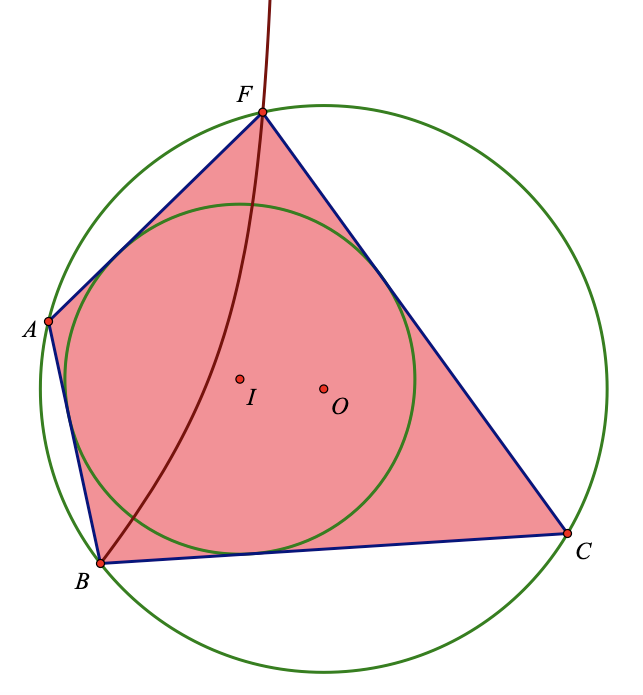Some other bicentric quadrilateral constructions
Proof: It follows from the 1st construction above that the opposite angles at A and C are supplementary, which implies ABCD is also cyclic; and hence bicentric.
Published paper: De Villiers, M. (2021). Another Bicentric Quadrilateral Construction. Learning & Teaching Mathematics, No. 31, pp. 40-41.
Using Fuss' theorem: The distance d between the incentre and circumcentre of a bicentric quadrilateral was derived by Nicolaus Fuss (1755-1826) in 1792 and is given by the following formula:
d = √(R2 + r2 - r √(4R2 + r2)) where r and R are respectively the inradius & the circumradius.
In the above sketch click on the 'Link to Fuss construction' button. We can now use this formula to construct a bicentric quadrilateral as follows:
1) Start with two segments R = AB and r = CD for the respective radii of the circumcircle and incircle.
2) With your software, calculate the distance d between the circumcentre & incentre with Fuss' formula. Construct circle E with radius R = AB, and with E as centre also, construct another circle with radius d.
3) Choose a point F on this latter circle and with it as centre, construct a circle with radius r = CD.
4) Then construct a tangential quadrilateral to the incircle by first constructing a tangent GH with G and H the intersection of this tangent with the circumcircle. Next construct the tangents GJ and HI to obtain a tangential quadrilateral GHIJ.
5) By Poncelet's porism one can drag either of K and/or F to get an infinite family of bicentric quadrilaterals GHIJ for these two circles. One can also drag the respective radii AB and CD to change the distance between the centres.
Challenge: Can you find other methods of constructing a bicentric quadrilateral?
Dan Bennett's Construction A long-time colleague & friend, Dan Bennett, who is a Math Teacher at John O’Connell HS, San Francisco CA, recently sent me (2 June 2021) the following novel bicentric quadrilateral construction using Sketchpad (see sketch below):
1) Construct rays BA and BC and angle bisector of ∠B. The points A, B, and C will be three free vertices of the final quadrilateral (that can be dragged).
2) Construct a point D on the angle bisector and drop a perpendicular to one of the rays. Construct a circle to this intersection that will be tangent to the two rays.
3) From A and C, construct the other lines tangent to the circle you just made. Construct point E at their intersection. ABCE is now a quadrilateral that has an incircle.
4) Construct the circumcircle of ABC.
5) Construct the locus of point E as point D moves on the angle bisector. This is a hyperbola, because BA + CE = BC + AE.
6) Construct point F at the intersection of the hyperbola and the circumcircle. ABCF is the desired bicentric quad.
This construction appears to affirm the plausible conjecture that for any three non-collinear points A, B, and C, there exists a unique fourth point F such that ABCF is bicentric.

Notes:
i) Since the Sketchpad sketch involves the intersection of a locus (of a conic) and a circle, it unfortunately does not convert to WebSketchpad. However, Sketchpad users can download & unzip the Sketchpad sketch from here: Bennett GSP Construction.
ii) Dan has now also discovered that two vertices of the quadrilateral are the foci of the hyperbola - so he was able to do the same construction in GeoGebra using the hyperbola tool instead of the locus tool. However, since the hyperbola intersects the circumcircle in four points, only one of which is the correct fourth vertex of the quad, the construction breaks very easily. The intersection bounces among the four possible locations seemingly randomly. Here's his dynamic GeoGebra sketch online: Bennett Construction 2.
iii) Users of other dynamic geometry software are invited to duplicate Dan Bennett's construction for themselves.
Some Related Links
Some Bicentric Quadrilateral Properties
Some Properties of Bicentric Isosceles Trapezia & Kites
Triangle Circumcircle Incentre Result
Japanese theorem for cyclic quadrilaterals
Cyclic Quadrilateral Angle Bisectors Rectangle Result
Cyclic Hexagon Alternate Angles Sum Theorem
Circumscribed Hexagon Alternate Sides Theorem
Semi-regular Angle-gons and Side-gons: Generalizations of rectangles and rhombi
Alternate sides cyclic-2n-gons and Alternate angles circum-2n-gons: Generalizations of isosceles trapezia and kites
Angle Divider Theorem for a Cyclic Quadrilateral
Side Divider Theorem for a Circumscribed/Tangential Quadrilateral
Conway’s Circle Theorem as special case of Side Divider (Windscreen Wiper) Theorem
Tangential Quadrilateral Theorem of Gusić & Mladinić
Concurrent Angle Bisectors of a Quadrilateral
Visually Introducing & Classifying Quadrilaterals by Dragging (Grades 1-7)
An Inclusive, Hierarchical Classification of Quadrilaterals
Some External Links
Bicentric quadrilateral (Wikipedia)
SA Mathematics Olympiad Questions and worked solutions for past South African Mathematics Olympiad papers as well as books on problem solving can be found at this link.
(Note, however, that prospective users will need to register and log in to be able to view past papers and solutions.)
Free Download of Geometer's Sketchpad
********************************
Back to "Dynamic Geometry Sketches"
Back to "Student Explorations"
Created 25 May 2021 by Michael de Villiers; updated 5 June 2021; 15 May 2025.